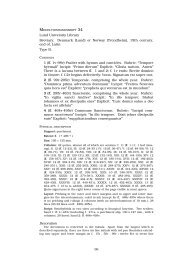Lund University Library Olim - St. Laurentius Digital Manuscript Library
Lund University Library Olim - St. Laurentius Digital Manuscript Library
Lund University Library Olim - St. Laurentius Digital Manuscript Library
Create successful ePaper yourself
Turn your PDF publications into a flip-book with our unique Google optimized e-Paper software.
6 Medieval <strong>Manuscript</strong> Catalogue Mh 2<br />
white vine stem against blue and green background. Begins Dominica iiii post<br />
octava paschae "Karissimi. Estote factores uerbi"; f. 36v : 6-line initial (P) simple<br />
white vine stem against blue, green and yellow background. Begins In die ascensionis<br />
domini "Primum quidem sermonem"; f. 39v : 5-line initial (D), white vine<br />
stem with knot around the curve against blue, green and yellow background.<br />
Begins Die pentecosten "Dum conplerentur dies pentecostes"; f. 57r : the reading<br />
for Dominica ultima post trinitatem, here called Dominica v ante natalem domini,<br />
is incomplete. It ends with Hieremias "Ecce dies ueniunt dicit dominus", which<br />
should have been followed by Isaiah 10:22-27, possibly originally placed on the<br />
missing first folio. Compare with Medeltidshandskrift 5 where the end of this reading<br />
precedes the reading of Dominica iiii ante natiuitate Domini; f. 57v : large 8-line<br />
initial (D) of type a. Red outline drawing with a horizontally symmetrical arrangement<br />
of white vine stem filling the center without transgressing the limitations of<br />
the letter with the exception of two leaves twisting around the staff. Two small<br />
flower buds make the serifs and the branch forks are indicated by series of short<br />
strokes. Begins the proprium sanctorum: Idus decembris natale sanctae Luciae<br />
"Domine deus meus". As the reading for <strong>St</strong>a Lucia on f. 1r is followed by <strong>St</strong>.<br />
Thomas and <strong>St</strong>. Sylvester, and <strong>St</strong>. Andreas on f. 72v is followed by both <strong>St</strong>a.<br />
Barbara and the octave of <strong>St</strong>. Andreas, the order does not coincide either with the<br />
astronomical or the usual ecclesiastical calendar, but must be understood as a significant<br />
deviation in order to emphasize the position of <strong>St</strong>a. Lucia. In Medeltidshandskrift<br />
5, the other <strong>Lund</strong>ensian epistolary, for comparison, the proprium sanctorum<br />
begins with <strong>St</strong>. Sylvester and ends with <strong>St</strong>. Andreas, whereas the reading<br />
for <strong>St</strong>a. Lucia is anonymously entered under the common rubric De virginibus.<br />
<strong>St</strong>yle: Ewert Wrangel has suggested a south German origin based on general<br />
assumptions concerning Romanesque white vine stem decoration. Per Ekström<br />
noted the names of Ursmar and Lambert, and questioned the manuscript’s local<br />
origin, i.e. liturgical use, but without giving an alternative place of production.<br />
Though the buds and the disposition of the leaves are clearly derived from late<br />
ottonian and salian decoration, the particular inward curled floral ornaments are<br />
not usually found in German book illumination of the 12th century, but are rather<br />
reminescent of the 11th century manuscripts from the scriptoria at Gembloux and<br />
Lobbes. Also the backgrounds with contrasting bright colours are common in early<br />
Romanesque Flemish manuscripts. The style is totally coherent with the Flemish<br />
elements of the liturgical apparatus, which in combination give a fairly narrow<br />
frame of attribution. The place of origin is undoubtedly located in the see of Liège,<br />
with the highest probability in Lobbes or Gembloux if not Rolduc itself. Provided<br />
that Heriman of Schleswig is the intermediary link or even the commissioner, the<br />
terminus post quem is given by the foundation of Rolduc in 1104 and the terminus<br />
ante quem by Heriman’s leaving Rolduc in 1129.<br />
Numerous fragments from a 12th century missal (now Fragm. 93) taken from<br />
the secondary binding of Medeltidshandskift 7 (Liber daticus) show the same initials<br />
against a background of multicoloured fields and a very similar script to that<br />
of Medeltidshandskrift 2, suggesting a common origin.<br />
Binding<br />
Size: 244 (endbands included approx. 272) x 160 x 42 mm. Romanesque white<br />
leather bindingover square edged oak boards; Belgium, Lobbes contemporary with<br />
manuscript. Covering material of lower board corner torn and later pasted. The<br />
covering at the head of the upper cover has two holes with rust from former fastenings<br />
or a frame. Two edged-pegged iron fastenings closing on the upper cover are<br />
missing. Flat spine. <strong>Manuscript</strong> title in ink at the tail (worn) and a blind-tooled<br />
library label of paper at the head of the back. Silk embroidered tabendband on two<br />
double supports, yellow silk on parchment strips, secondary embroidery of green<br />
silk over a multicoloured woven textile band (defect and worn). Trimmed edges, no<br />
squares. Endleaves missing. All along sewing on three white slit leather thongs<br />
laced through the board-edge. The tail turn-in of the lower cover shows a clear<br />
imprint in blind of a textile fragment (cfr. Szirmai 1999 pp. 140 ff.).<br />
According to a note on the old catalogue card the parchment was glued to the<br />
wooden boards in 1936. Presumably at that moment the two loose sheets with<br />
musical notation (now Fragm. 2) were taken out of the binding; f. 1 of the fragment














